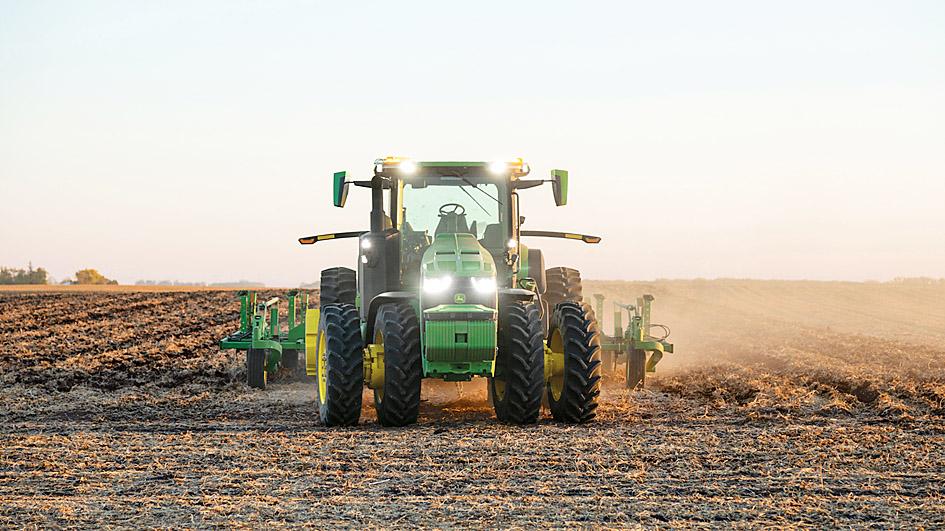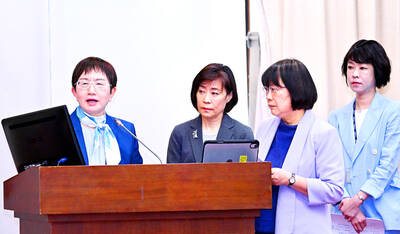A robot army is beginning its march across rural US, promising to transform the future of food. Twenty-five intelligent machines were last month dispatched to the Midwest and the Mississippi Delta, where they are to travel over newly planted fields at 19kph, annihilating baby weeds.
Produced by John Deere and created by the start-up Blue River Technology Inc, these robotic weeders look much like standard industrial sprayers at first glance, but each is rigged with an intricate system of 36 cameras and a mass of tiny hoses. They use computer vision to distinguish between crops and weeds and then deploy with sniper-like precision tiny jets of herbicide onto the weeds — sparing the crop and ending the common practice of broadcast-spraying chemicals across billions of acres.
The “See and Spray Ultimate” robots are expensive, enormous, wildly complex machines accessible only to industrial-scale farmers, but within a few years their effect on the environment and human health could be nothing short of spectacular. They are in the vanguard of a wave of reimagined agricultural equipment that is expected to help farmers produce more food on less land with radically reduced chemical applications.

Photo: AP
Intelligent machines can treat plants individually, eventually applying not just herbicides, but pesticides, fungicides and fertilizers on a plant-by-plant — rather than field-by-field — basis. This kind of hyper-precision might do more than ratchet down agrochemical usage, also allowing for more diversity and crop-mixing on fields, so that larger farms can begin to mimic natural systems.
Meanwhile, robotic planters and combines are already showing yield improvements of up to 2 percent, and robotic harvesters could eventually alleviate increasingly grueling farm work and labor shortages.
Robots on farms, for all their environmental and ethical promise, raise plenty of concerns — some valid, others spurious. They would add cost and complexity to farming equipment, making farmers increasingly reliant on “big ag” companies such as John Deere.
In the beginning, they would reinforce the dominance of large industrial operators while eluding the local small and midsize farmers who are essential to sustainable and resilient food systems.
So as the era of artificial intelligence (AI) in farming dawns, manufacturers, US President Joe Biden’s administration and investors should be thinking about how to develop this market responsibly.
Funding should be steered to the development of smaller, more affordable machines, while also supporting a rental economy that enables local and midsize farmers to lease, if not own, this next-generation equipment.
The US Department of Agriculture (USDA) should also create rebate and tax credit programs to help farmers affordably trade out old machinery for new.
See and Spray is one of seven AI products that John Deere has in development, including robotic planters, self-driving tractors and combines that meticulously separate wheat from chaff. All are equipped with dozens of cameras and algorithm-crunching data processors that examine, analyze and measure every plant and seed on a field.
“We’re doubling down, tripling down on investment in robotics and machine learning,” said Jorge Heraud, John Deere’s vice president of automation and machine autonomy.
Having grown up working on and weeding his grandparents’ tomato farm in Peru, Heraud founded Blue River Technology, which John Deere acquired in 2017 along with its See and Spray prototype for US$305 million. In five years, Heraud has helped grow John Deere’s AI team to 400 people from 50.
Many skeptics question whether this equipment would ever be widely adopted.
John Deere says it already has more demand than it is ready to meet: Heraud decided to release only 25 in its first fleet, because the company is still honing the financing and servicing model.
John Deere is charging an upfront price that it would not disclose — it is at least the cost of a standard sprayer of the same size, about US$500,000 — plus an ongoing per-acre fee that might be charged monthly or annually and includes software upgrades and maintenance.
Heraud plans to increase the fleet by a factor of 10 annually, so that by 2025 the company would have thousands of robotic weeders on the market.
The worry that intelligent machines will simply make industrial farms bigger and farmers lazier, less responsible stewards of the land is unfounded.
These kinds of advanced technologies have extraordinary potential to help farmers improve the health of their soil and the quality of the food they produce by drastically reducing the use of harmful chemical herbicides such as glyphosate, Dicamba and 2,4-D.
Twenty billion gallons (75.7 billion liters) of herbicide are applied annually by sprayers worldwide across 404.69 million hectares of farmland.
When See and Spray technology is integrated into all sprayers sold by the company, which Heraud said could happen within a decade, the volume of herbicide deployed on these farms could plummet to 4 billion gallons.
Future generations of the equipment might also be able to significantly curtail the use of fossil fuel-derived fertilizers, which, when over-applied, fuel climate change.
Governments can help allay concerns with incentives: The California Air Resources Board provides a helpful model, offering farmers rebates for upgrading their existing machinery to models with cleaner engines.
The USDA and investors can also encourage the development of a rental economy by incentivizing and funding young companies such as Nutrien Ag Solutions in the US and Hello Tractor in Africa that function like the Ubers of agriculture, enabling small and midsize farmers to lease or acquire fractional ownership of next-generation farm equipment without having to maintain it or learn the technology.
Venture capital can be directed to support new players in the AI market. One young start-up, Earthsense, is developing robots the size of microwaves that rove around farms removing weeds. John Deere is also working on smaller, more affordable machines.
For better or worse, the era of AI agriculture has arrived, and if investors and government officials do their part to support the responsible development and adoption of this technology, the result would be nothing short of a paradigm shift toward sustainable farming.
Virtually every aspect of food production, from planting to processing, could be revolutionized, making it feasible to feed a hotter, more populous world.
Amanda Little is a Bloomberg Opinion columnist covering agriculture and climate. She is a professor of journalism and science writing at Vanderbilt University.
This column does not necessarily reflect the opinion of the editorial board or Bloomberg LP and its owners.

‘SWASTICAR’: Tesla CEO Elon Musk’s close association with Donald Trump has prompted opponents to brand him a ‘Nazi’ and resulted in a dramatic drop in sales Demonstrators descended on Tesla Inc dealerships across the US, and in Europe and Canada on Saturday to protest company chief Elon Musk, who has amassed extraordinary power as a top adviser to US President Donald Trump. Waving signs with messages such as “Musk is stealing our money” and “Reclaim our country,” the protests largely took place peacefully following fiery episodes of vandalism on Tesla vehicles, dealerships and other facilities in recent weeks that US officials have denounced as terrorism. Hundreds rallied on Saturday outside the Tesla dealership in Manhattan. Some blasted Musk, the world’s richest man, while others demanded the shuttering of his

Taiwan’s official purchasing managers’ index (PMI) last month rose 0.2 percentage points to 54.2, in a second consecutive month of expansion, thanks to front-loading demand intended to avoid potential US tariff hikes, the Chung-Hua Institution for Economic Research (CIER, 中華經濟研究院) said yesterday. While short-term demand appeared robust, uncertainties rose due to US President Donald Trump’s unpredictable trade policy, CIER president Lien Hsien-ming (連賢明) told a news conference in Taipei. Taiwan’s economy this year would be characterized by high-level fluctuations and the volatility would be wilder than most expect, Lien said Demand for electronics, particularly semiconductors, continues to benefit from US technology giants’ effort

ADVERSARIES: The new list includes 11 entities in China and one in Taiwan, which is a local branch of Chinese cloud computing firm Inspur Group The US added dozens of entities to a trade blacklist on Tuesday, the US Department of Commerce said, in part to disrupt Beijing’s artificial intelligence (AI) and advanced computing capabilities. The action affects 80 entities from countries including China, the United Arab Emirates and Iran, with the commerce department citing their “activities contrary to US national security and foreign policy.” Those added to the “entity list” are restricted from obtaining US items and technologies without government authorization. “We will not allow adversaries to exploit American technology to bolster their own militaries and threaten American lives,” US Secretary of Commerce Howard Lutnick said. The entities

Minister of Finance Chuang Tsui-yun (莊翠雲) yesterday told lawmakers that she “would not speculate,” but a “response plan” has been prepared in case Taiwan is targeted by US President Donald Trump’s reciprocal tariffs, which are to be announced on Wednesday next week. The Trump administration, including US Secretary of the Treasury Scott Bessent, has said that much of the proposed reciprocal tariffs would focus on the 15 countries that have the highest trade surpluses with the US. Bessent has referred to those countries as the “dirty 15,” but has not named them. Last year, Taiwan’s US$73.9 billion trade surplus with the US